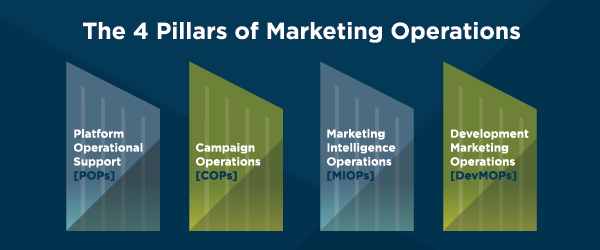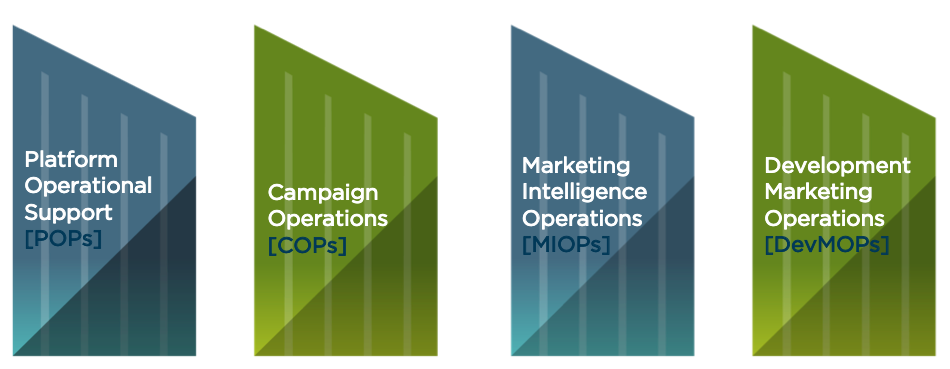 The Marketing industry (especially B2B) is experiencing a massive surge in Marketing Technology (MarTech). Everywhere you look, there are new tools popping up. The speed of growth is creating an environment of inflated prices and abundant choices.
The Marketing industry (especially B2B) is experiencing a massive surge in Marketing Technology (MarTech). Everywhere you look, there are new tools popping up. The speed of growth is creating an environment of inflated prices and abundant choices.
One topic discussed less frequently, is the growing vocation of Marketers who operate this tech day-to-day: Marketing Operations. As MarTech grows in complexity, with multiple layers working in tandem, these Marketing practitioners are tasked with managing and determining which toolset combinations create business results.
What is Marketing Operations?
“Marketing Operations” (MOPs) is a department and/or role that employs technology to improve (1) Marketing Efficiency and (2) Marketing Effectiveness. The vocation is evolving quickly. Its name, Marketing Operations, has been around for years: though many companies are only now figuring out the right formula.
In small organizations, Marketing Operations is usually only one or two people sharing all responsibilities. These are generalists who manage all aspects of MOPs: building email campaigns, reports, tool integrations, and ad-hoc problem-solving.
In large/growing teams, Marketing Operations begins to require specialization. Roles form around skill sets involving: Administration, Architecting, Building, Testing, Reporting, Data Science, Front-End Development, Custom Tool Creation/Management, System Integrations, etc.
Scott Brinker of “Chief Marketing Technologist” has been a key player in popularizing MarTech as an industry, creating the title, “Marketing Technologist.” After engaging with hundreds of B2B companies running Marketing Automation successfully, we have found “Marketing Technologist” titles do not stand the scrutiny of daily organizational operations. Instead, titles aligned to “Marketing Operations” are less trend-dependent, focusing on how companies are actually functioning. In my opinion, the reach to “Chief Marketing Technologist” as a suggested C-level role, is both impractical and highly unlikely. This reality and comparison can also be seen directly via Google Trends:
Etumos is setting out to define, shape, and proselytize the Marketing Operations vocation: sharing the roles and structures we have seen that deliver success. Instead of a “Chief Marketing Technologist,” we need a “VP of Marketing Operations.”
“VP of Marketing Operations” as a role:
To understand the VP of Marketing Operations (VP MOPs) role, we need to understand what comprises successful MOPs teams. What are the foundational elements? Through the years, we have seen companies struggle to organize into impactful teams with clearly defined roles.
When operations teams become functional, they are capable of delivering complex requests, guiding strategic initiatives, and maturing entire organizations. The foundational components that create a functional team can be grouped into four main pillars. Each pillar has its own set of roles and responsibilities: all work together.
The 4 Pillars of Marketing Operations:

Platform Operations (POPs)
- Administration
- Architecting
- Governance
Campaign Operations (COPs)
- Building
- Setting and Sending Emails
- Testing and QA
Marketing Intelligence Operations (MIOPs)
- Reporting
- Data Science
Development (Dev MOPs)
- Front-End Development
- Custom Tool Creation/Management
- Integrations
The VP of Marketing Operations holds these teams together, leading through the articulation of a compelling vision and direction. Working to manufacture and drive consensus around this vision, and successfully blocking and tackling for their teams while in pursuit. They must also assess how each team is running on a day-to-day basis and whether the complementary MarTech tools across each pillar are working together, creating results, and enabling the team to achieve its ultimate goal: improving marketing efficiency and marketing effectiveness.
It is the congregation of these pillars, led and represented by a strong VP of Marketing Operations, that defines today’s best-practices Marketing Operations department.
Check out our next blog in this series, How to Build a High-Powered Marketing Operations Team.







